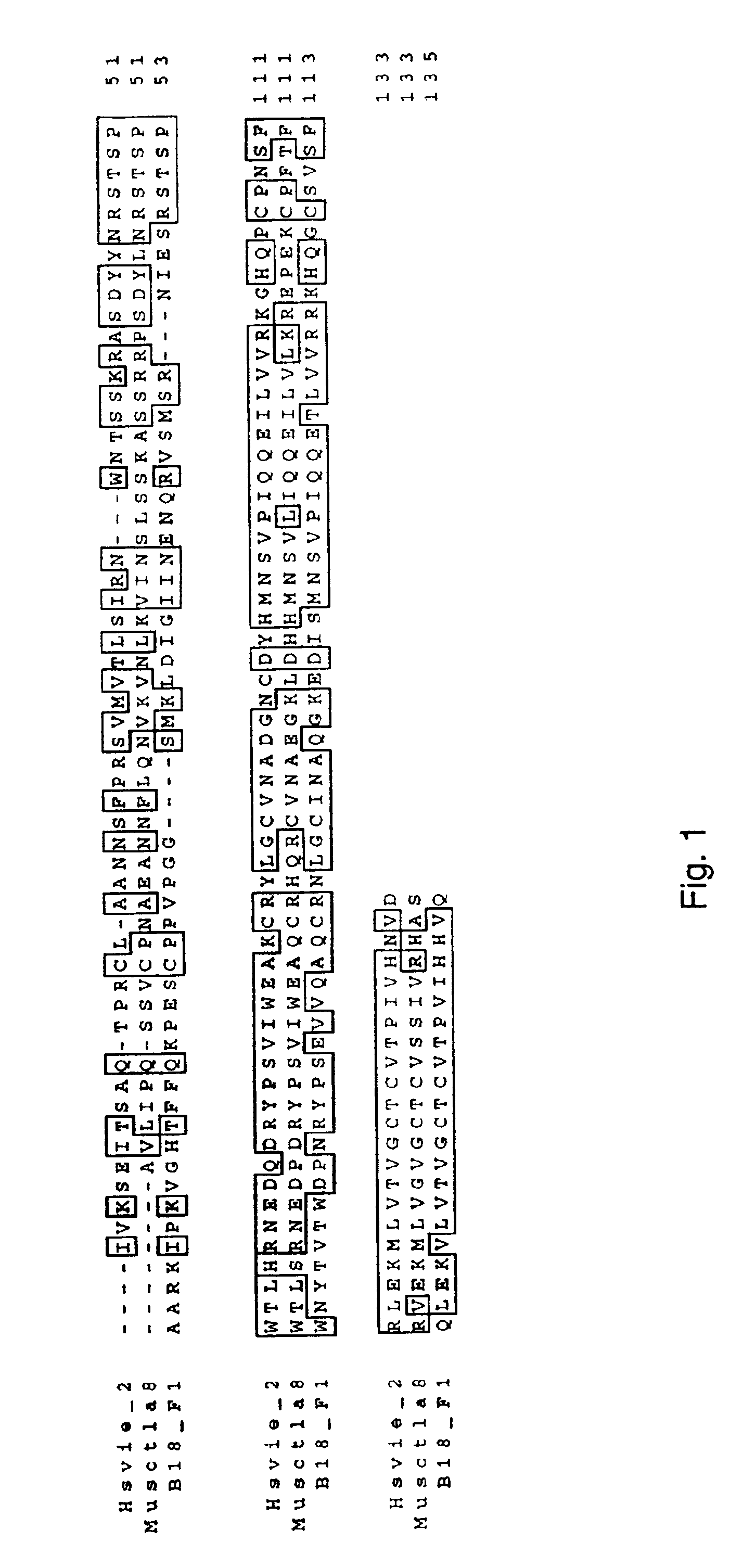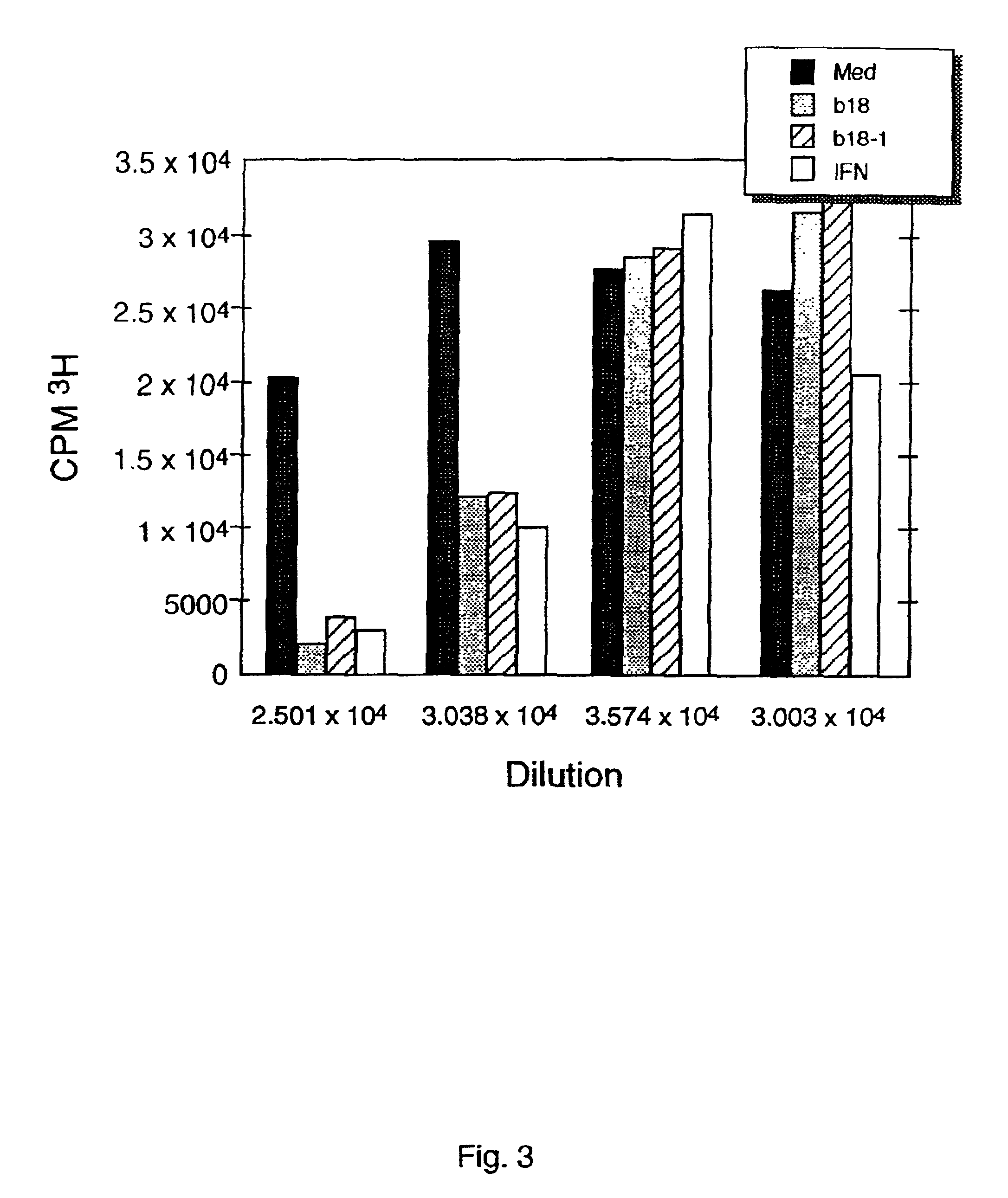Antibodies to human IL-17F and other CTLA-8-related proteins
a technology of ctla-8 and antibodies, applied in the field of human ctla8 proteins, can solve the problems of limited cytokine detection, limited pcr approach, and inability to detect cytokine,
- Summary
- Abstract
- Description
- Claims
- Application Information
AI Technical Summary
Benefits of technology
Problems solved by technology
Method used
Image
Examples
example 1
Isolation of Human CTLA-8 cDNA
[0095]A partial clone for human CTLA-8 was isolated from a cDNA library made from RNA isolated from stimulated human peripheral blood mononuclear cells. This partial was identified as “B18.” B18 is sometimes used herein to refer to the human CTLA-8 of the present invention. Homology searches identified this partial clone as being related to the herpes and rat CTLA-8 genes. DNA sequence of this partial clone was used to isolate the full-length clone.
[0096]In order to isolate a full-length cDNA for B18, a directional, full-length cDNA library by standard means in the COS expression vector pMV2. The cDNA library was transformed into E. coli by electroporation. The bulk of the original transformed cDNA library was frozen in glycerol at −80° C. An aliquot was titered to measure the concentration of transformed E. coli. The E. coli were thawed, diluted to 76.000 / 0.1 ml in media containing ampicillin, and 0.1 ml was distributed into the wells of a microtiter d...
example 2
Expression of Human CTLA-8
[0106]The full-length B18 clone for human CTLA-8 was transfected into COS cells which were then labelled with 35S-methionine. An aliquot of conditioned medium from the transfected cell culture was reduced, denatured and electrophoresed on polyacrylamide gels. Autoradiographs of those gels are reproduced in FIG. 2. The band indicated by the arrow demons expression of human CTLA-8.
example 3
Inhibition of Angiogenesis by Human CTLA-8
[0107]The ability of human CTLA-8 to inhibit angiogenesis was examined in an angiostatic activity assay (endothelial cell proliferation assay). The assay was done in a 96 well plate. Primary human umbilical cells (HUVECs) were seeded to 2×10′ cells per well in EGM medium (Clonetics) / 20% FCS and incubated at 37° C. for 24 hr. The cells were then starved in M199 medium (GIBCO BRL) containing 10% charcoal treated serum (M199-CS) for 48 hr at 37° C. Conditioned media containing B18 (human CTLA-8) was obtained from transfected COS or stably expressing CHO cells and 1:10, 1:50, 1:250, and 1:1250 dilutions prepared in M199-CS medium containing 100 ng / ml FGF. The dilutions of B18 were added to the starved cells and incubated for 72 hr at 37° C. The cells were then radiolabeled by [3H]-thymidine for 6 hr. Radiolabeled cells were washed with PBS and trypsinized for liquid scintilation counting. Results were plotted using Kaleidograph software. The res...
PUM
| Property | Measurement | Unit |
|---|---|---|
| weight | aaaaa | aaaaa |
| weight | aaaaa | aaaaa |
| weight | aaaaa | aaaaa |
Abstract
Description
Claims
Application Information
 Login to View More
Login to View More - R&D
- Intellectual Property
- Life Sciences
- Materials
- Tech Scout
- Unparalleled Data Quality
- Higher Quality Content
- 60% Fewer Hallucinations
Browse by: Latest US Patents, China's latest patents, Technical Efficacy Thesaurus, Application Domain, Technology Topic, Popular Technical Reports.
© 2025 PatSnap. All rights reserved.Legal|Privacy policy|Modern Slavery Act Transparency Statement|Sitemap|About US| Contact US: help@patsnap.com



